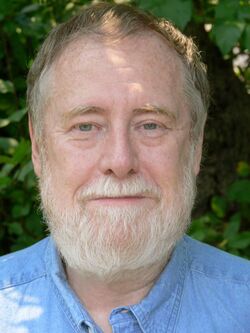Biography:Scott Fahlman
Scott Fahlman | |
|---|---|
 | |
| Born | Scott Elliott Fahlman March 21, 1948 Medina, Ohio, U.S. |
| Citizenship | United States |
| Education | Massachusetts Institute of Technology B.S., M.S. (1973) Ph.D. (1977) |
| Known for | Automated planning and scheduling: blocks world Semantic networks Neural networks Dylan Common Lisp: CMU Common Lisp Lucid Inc. |
| Awards | Fellow, American Association for Artificial Intelligence |
| Scientific career | |
| Fields | Computer science Natural language processing |
| Institutions | Carnegie Mellon University |
| Thesis | NETL: A System for Representing and Using Real-World Knowledge (1977) |
| Doctoral advisor | Gerald Jay Sussman |
| Other academic advisors | Patrick Winston |
| Doctoral students | David S. Touretzky Michael Witbrock |
| Website | {{{1}}} |
Scott Elliott Fahlman (born March 21, 1948) is an American computer scientist and Professor Emeritus at Carnegie Mellon University's Language Technologies Institute and Computer Science Department. He is notable for early work on automated planning and scheduling in a blocks world, on semantic networks, on neural networks (especially the cascade correlation algorithm), on the programming languages Dylan, and Common Lisp (especially CMU Common Lisp), and he was one of the founders of Lucid Inc. During the period when it was standardized, he was recognized as "the leader of Common Lisp."[1] From 2006 to 2015, Fahlman was engaged in developing a knowledge base named Scone, based in part on his thesis work on the NETL Semantic Network.[2] He also is credited with coining the use of the emoticon.
Life and career
Fahlman was born in Medina, Ohio, the son of Lorna May (Dean) and John Emil Fahlman. He attended the Massachusetts Institute of Technology (MIT), where he received a Bachelor of Science (B.S.) and Master of Science (M.S.) degree in electrical engineering and computer science in 1973, and a Doctor of Philosophy (Ph.D.) in artificial intelligence in 1977. He has noted that his doctoral diploma says the degree was awarded for "original research as demonstrated by a thesis in the field of Artificial Intelligence" and suggested that it may be the first doctorate to use that term.[3] He is a fellow of the American Association for Artificial Intelligence.
Fahlman acted as thesis advisor for Donald Cohen, David B. McDonald, David S. Touretzky, Skef Wholey, Justin Boyan, Michael Witbrock, and Alicia Tribble Sagae.
From May 1996 to July 2001, Fahlman directed the Justsystem Pittsburgh Research Center.
Emoticons
Fahlman was not the first to suggest the concept of the emoticon – a similar concept for a marker appeared in an article of Reader's Digest in May 1967, although that idea was never put into practice.[4]
In an interview printed in The New York Times in 1969, Vladimir Nabokov noted:
"I often think there should exist a special typographical sign for a smile – some sort of concave mark, a supine round bracket."[5]
Fahlman is credited with originating the first smiley emoticon,[6][7][8] which he thought would help people on a message board at Carnegie Mellon to distinguish serious posts from jokes. He proposed the use of :-) and :-( for this purpose, and the symbols caught on. The original message from which these symbols originated was posted on 19 September 1982. The message was recovered by Jeff Baird on 10 September 2002 and read:[9]
19-Sep-82 11:44 Scott E Fahlman :-) From: Scott E Fahlman <Fahlman at Cmu-20c> I propose that the following character sequence for joke markers: :-) Read it sideways. Actually, it is probably more economical to mark things that are NOT jokes, given current trends. For this, use :-(
References
- ↑ Patterns of Software, Oxford University Press, 1996, p. 183, https://dreamsongs.com/Files/PatternsOfSoftware.pdf, retrieved 2020-01-25
- ↑ "The Scone Knowledge-Base Project". Carnegie Mellon University. https://www.cs.cmu.edu/~sef/scone/. "Scone is a high-performance, open-source knowledge-base (KB) system intended for use as a component in many different software applications."
- ↑ Fahlman, Scott E. (5 March 2019). "Who was the first person to get a PhD degree specifically in "Artificial Intelligence"?". https://www.quora.com/Who-was-the-first-person-to-get-a-PhD-degree-specifically-in-Artificial-Intelligence/answer/Scott-E-Fahlman.
- ↑ "Fact Check: Emoticon (Smiley) Origin". 20 September 2007. http://www.snopes.com/computer/internet/smiley.asp.
- ↑ Nabokov, Vladimir (1973), Strong Opinions, New York, pp. 133–134, ISBN 0-679-72609-8, https://archive.org/details/isbn_9780679726098/page/133
- ↑ "The Man Who Brought a :-) to Your Screen". 22 April 2001. https://www.bloomberg.com/news/articles/2001-04-22/the-man-who-brought-a-to-your-screen.
- ↑ "Smiley Lore :-)". Carnegie Mellon University. https://www.cs.cmu.edu/~sef/sefSmiley.htm.
- ↑ -) turns 25, Associated Press, 2007-09-20, http://www.cnn.com/2007/TECH/09/18/emoticon.anniversary.ap/index.html, retrieved 2007-09-20
- ↑ "Original Bboard Thread in which :-) was proposed". Carnegie Mellon University. http://www-2.cs.cmu.edu/~sef/Orig-Smiley.htm.
External links
 |

